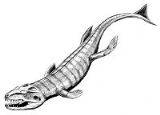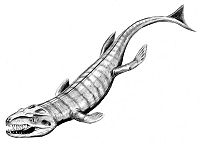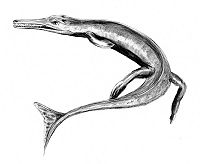
Berriasian
Encyclopedia
In the geological timescale, the Berriasian is an age or stage of the Early or Lower Creteceous
. It is the oldest or lowest subdivision in the entire Cretaceous
. It spanned between 145.5 ± 4.0 Ma and 140.2 ± 3.0 Ma (million years ago). The Berriasian succeeds the Tithonian
(part of the Jurassic
) and precedes the Valanginian
.
region of France
. The largely non-marine English Purbeck Formation is of Berriasian age and in the past the names Purbeck and Wealden were also used to address rocks of the lowest Cretaceous.
The base of the Berriasian (also the base of the Cretaceous system) has traditionally been placed at the first appearance of fossils of the ammonite
species Berriasella jacobi
. A global reference profile (a GSSP) for the Berriasian is under active consideration by the Cretaceous International Subcommission (ISCS) of IUGS. A range of contender GSSP localities are currently being studied by the ISCS's Berriasian Working Group. Several markers are being employed to refine correlations and to work towards definition of a stage base. These include calcareous nannofossils, such as Nannoconus steinmannii, calpionellids, ammonites, palynological datums and magnetostratigraphy, notably the base of chron m18r.
In the Tethyan Realm
, the Berriasian consists four ammonite biozone
s, from top to bottom:
The top of the Berriasian stage (the base of the Valanginian) is at the first appearance of calpionellid species Calpionellites darderi in the stratigraphic column. This is just a little below the first appearance of ammonite species Thurmanniceras pertransiens.
Early Cretaceous
The Early Cretaceous or the Lower Cretaceous , is the earlier or lower of the two major divisions of the Cretaceous...
. It is the oldest or lowest subdivision in the entire Cretaceous
Cretaceous
The Cretaceous , derived from the Latin "creta" , usually abbreviated K for its German translation Kreide , is a geologic period and system from circa to million years ago. In the geologic timescale, the Cretaceous follows the Jurassic period and is followed by the Paleogene period of the...
. It spanned between 145.5 ± 4.0 Ma and 140.2 ± 3.0 Ma (million years ago). The Berriasian succeeds the Tithonian
Tithonian
In the geologic timescale the Tithonian is the latest age of the Late Jurassic epoch or the uppermost stage of the Upper Jurassic series. It spans the time between 150.8 ± 4 Ma and 145.5 ± 4 Ma...
(part of the Jurassic
Jurassic
The Jurassic is a geologic period and system that extends from about Mya to Mya, that is, from the end of the Triassic to the beginning of the Cretaceous. The Jurassic constitutes the middle period of the Mesozoic era, also known as the age of reptiles. The start of the period is marked by...
) and precedes the Valanginian
Valanginian
In the geologic timescale, the Valanginian is an age or stage of the Early or Lower Cretaceous. It spans between 140.2 ± 3.0 Ma and 136.4 ± 2.0 Ma...
.
Stratigraphic definitions
The Berriasian stage was introduced in scientific literature by Henri Coquand in 1869. It is named after the village of Berrias in the ArdècheArdèche
Ardèche is a department in south-central France named after the Ardèche River.- History :The area has been inhabited by humans at least since the Upper Paleolithic, as attested by the famous cave paintings at Chauvet Pont d'Arc. The plateau of the Ardeche River has extensive standing stones ,...
region of France
France
The French Republic , The French Republic , The French Republic , (commonly known as France , is a unitary semi-presidential republic in Western Europe with several overseas territories and islands located on other continents and in the Indian, Pacific, and Atlantic oceans. Metropolitan France...
. The largely non-marine English Purbeck Formation is of Berriasian age and in the past the names Purbeck and Wealden were also used to address rocks of the lowest Cretaceous.
The base of the Berriasian (also the base of the Cretaceous system) has traditionally been placed at the first appearance of fossils of the ammonite
Ammonite
Ammonite, as a zoological or paleontological term, refers to any member of the Ammonoidea an extinct subclass within the Molluscan class Cephalopoda which are more closely related to living coleoids Ammonite, as a zoological or paleontological term, refers to any member of the Ammonoidea an extinct...
species Berriasella jacobi
Berriasella
Berriasella is a discoidal evolute perisphinctacean ammonite, and type genus for the neocomitid subfamily Berriasellinae. Its ribbing is distinct, consisting of both simple and bifurcated ribs that extend from the umbilical seam across the venter; its whorl section generally compressed, the venter...
. A global reference profile (a GSSP) for the Berriasian is under active consideration by the Cretaceous International Subcommission (ISCS) of IUGS. A range of contender GSSP localities are currently being studied by the ISCS's Berriasian Working Group. Several markers are being employed to refine correlations and to work towards definition of a stage base. These include calcareous nannofossils, such as Nannoconus steinmannii, calpionellids, ammonites, palynological datums and magnetostratigraphy, notably the base of chron m18r.
In the Tethyan Realm
Tethys Ocean
The Tethys Ocean was an ocean that existed between the continents of Gondwana and Laurasia during the Mesozoic era before the opening of the Indian Ocean.-Modern theory:...
, the Berriasian consists four ammonite biozone
Biozone
Biostratigraphic units or Biozones are intervals of geological strata that are defined on the basis of their characteristic fossil taxa....
s, from top to bottom:
- Thurmanniceras otopeta
- Subthurmannia boissieri
- Subthurmannia occitanica
- Berriasella jacobi
The top of the Berriasian stage (the base of the Valanginian) is at the first appearance of calpionellid species Calpionellites darderi in the stratigraphic column. This is just a little below the first appearance of ammonite species Thurmanniceras pertransiens.
Birds
| Birds of the Berriasian | ||||
|---|---|---|---|---|
| Taxa | Presence | Location | Description | Images |
|
||||
|
|
||||
|
Palaeocursornis Palaeocursornis is a monotypic genus of prehistoric bird. The species P. corneti, described in 1984, was initially assumed to be a flightless paleognathe, possibly a ratite, but it may actually be more primitive and not even a neornithine but an ornithuromorph bird or indeed not a bird at all... |
||||
|
Wyleyia Wyleyia is a prehistoric bird genus with a single species, Wyleyia valdensis, known from the Early Cretaceous of England. Even this is only known from a single damaged right humerus. It has been named to honor J. F. Wyley, who found the specimen in the Weald Clay deposits of Henfield in Sussex... |
||||
Crocodylomorphs
| Crocodylomorphs of the Berriasian | ||||
|---|---|---|---|---|
| Taxa | Presence | Location | Description | Images |
|
   |
|||
|
||||
|
Goniopholis Goniopholis is an extinct genus of crocodyliform that lived in North America, Europe and Asia during the Late Jurassic and Early Cretaceous. Being semi-aquatic it is very similar to modern crocodiles... |
||||
|
Lisboasaurus Lisboasaurus is a small genus of Mesozoic crocodylomorph that lived in fresh water. It is known from fossilized tooth and jaw fragments of Late Jurassic and Early Cretaceous age. Two species have been described. In the past Lisboasaurus has been interpreted as a Mid Jurassic avialan, troodontid,... |
||||
|
Steneosaurus Steneosaurus is an extinct genus of teleosaurid crocodyliform from the Early Jurassic to Early Cretaceous . Fossil specimens have been found in England, France, Germany, Switzerland and Morocco.-Species:... |
||||
Mammalia
| Mammals of the Berriasian | ||||
|---|---|---|---|---|
| Taxa | Presence | Location | Description | Images |
|
Durlston Bay, Dorset, England | |||
|
Bolodon Bolodon is a genus of extinct mammal from the Lower Cretaceous of Europe, and possibly the Upper Jurassic of North America. It was a member of the extinct order of Multituberculata and lived at the same time as dinosaurs. It is placed in the suborder Plagiaulacida and family Plagiaulacidae.The... |
Durlston Bay, Dorset, England; Spain | |||
|
Ecprepaulax Ecprepaulax is a Lower Cretaceous mammal from Portugal. It was a member of the also extinct order Multituberculata and shared the world with dinosaurs. It lies within the suborder "Plagiaulacida" and family Pinheirodontidae.... |
Portugal | |||
|
Gerhardodon Gerhardodon is an extinct genus of mammal from the Lower Cretaceous of southern England. It was a member of the also extinct order of Multituberculata, and lived with such dinosaurs as Iguanodon. It lies within the suborder "Plagiaulacida" and family Pinheirodontidae.The genus Gerhardodon was... |
Durlston Bay, Dorset, England | |||
|
Iberodon Iberodon is a small, extinct mammal of the Lower Cretaceous from Portugal. It was a member of the also extinct order Multituberculata, and led its obscure and plant-eating existence in the company of dinosaurs. It lies within the suborder "Plagiaulacida" and family Pinheirodontidae.The genus... |
Portugal | |||
†Ornithischians
| Ornithischians of the Berriasian | ||||
|---|---|---|---|---|
| Taxa | Presence | Location | Description | Images |
|
Swanage Swanage Swanage is a coastal town and civil parish in the south east of Dorset, England. It is situated at the eastern end of the Isle of Purbeck, approximately 10 km south of Poole and 40 km east of Dorchester. The parish has a population of 10,124 . Nearby are Ballard Down and Old Harry Rocks,... , England |
A bipedal herbivore, it was around 0.6 meters (2 ft) long. Unlike most ornithischians, Echinodon had one or two caniniform teeth in each maxilla. |
  |
|
|
||||
|
Owenodon Owenodon is a genus of iguanodontian dinosaur known from a partial lower jaw discovered in Early Cretaceous-age rocks of Durlston Bay, Dorset, United Kingdom. The specimen, NHM R2998, comes from the Purbeck Limestone, dating to the middle Berriasian stage... |
||||
|
Paranthodon Paranthodon was a dinosaur from the early Cretaceous. It lived in what is now South Africa. It is classified as a stegosaur. It has a long and confusing history. The type species, Paranthodon africanus, comes from a partial skull first described as Palaeoscincus africanus in 1912... |
Kirkwood Formation Kirkwood Formation The Kirkwood Formation is a geological formation in Eastern Cape and Western Cape provinces, South Africa whose strata date back to the Early Cretaceous... , Cape Province, South Africa |
A 4 meters long, 1.8 meters high stegosaurid with a skull similar to Kentrosaurus Kentrosaurus Kentrosaurus is a genus of stegosaurid dinosaur from the Late Jurassic of Tanzania. Its fossils have been found only in the Tendaguru Formation of Tanzania, dated to the Kimmeridgian stage, between about 155.7 ± 4 Ma and 150.8 ± 4 Ma . Apparently, all finds belong to one species, K... |
||
|
Valdosaurus Valdosaurus is a genus of bipedal herbivorous iguanodont ornithopod dinosaur found on the Isle of Wight and elsewhere in England. It lived during the Early Cretaceous.-Discovery and naming:... |
Isle of Wight, England; Niger, Africa | A dryosaurid | ||
†Pterosaurs
| Pterosaurs of the Berriasian | ||||
|---|---|---|---|---|
| Taxa | Presence | Location | Description | Images |
|
||||
†Sauropods
| Sauropods Sauropoda Sauropoda , or the sauropods , are an infraorder of saurischian dinosaurs. They had long necks, long tails, small heads , and thick, pillar-like legs. They are notable for the enormous sizes attained by some species, and the group includes the largest animals to have ever lived on land... of the Berriasian |
||||
|---|---|---|---|---|
| Taxa | Presence | Location | Description | Images |
|
|
|||
|
||||
|
Turiasaurus Turiasaurus is a genus of sauropod dinosaur from the Jurassic-Cretaceous boundary... |
||||
|
Xenoposeidon Xenoposeidon is a genus of sauropod dinosaur from the Early Cretaceous of England, living about 140 million years ago. It is known from a single partial vertebra with unusual features, unlike those of other sauropods... |
||||
|
|
||||
†Thalattosuchia
| †Thalattosuchians of the Berriasian | ||||
|---|---|---|---|---|
| Taxa | Presence | Location | Description | Images |
|
From Kimmeridgian Kimmeridgian In the geologic timescale, the Kimmeridgian is an age or stage in the Late or Upper Jurassic epoch or series. It spans the time between 155.7 ± 4 Ma and 150.8 ± 4 Ma . The Kimmeridgian follows the Oxfordian and precedes the Tithonian.... to Valanginian Valanginian In the geologic timescale, the Valanginian is an age or stage of the Early or Lower Cretaceous. It spans between 140.2 ± 3.0 Ma and 136.4 ± 2.0 Ma... |
Austria, England, Germany, Portugal and Switzerland | ||
|
Steneosaurus Steneosaurus is an extinct genus of teleosaurid crocodyliform from the Early Jurassic to Early Cretaceous . Fossil specimens have been found in England, France, Germany, Switzerland and Morocco.-Species:... |
Attested since Toarcian Toarcian The Toarcian is, in the ICS' geologic timescale, an age or stage in the Early or Lower Jurassic. It spans the time between 183.0 Ma and 175.6 Ma... |
England, France, Germany, Switzerland and Morocco | ||
†Theropods (non-avian)
| †Non-avian Paraphyly A group of taxa is said to be paraphyletic if the group consists of all the descendants of a hypothetical closest common ancestor minus one or more monophyletic groups of descendants... theropods Theropoda Theropoda is both a suborder of bipedal saurischian dinosaurs, and a clade consisting of that suborder and its descendants . Dinosaurs belonging to the suborder theropoda were primarily carnivorous, although a number of theropod groups evolved herbivory, omnivory, and insectivory... of the Berriasian |
||||
|---|---|---|---|---|
| Taxa | Presence | Location | Description | Images |
|
|
|||
|
||||
|
Nuthetes Nuthetes is the name given to a dubious, possibly dromaeosaurid, genus of theropod dinosaur, known only from fossil teeth and jaw fragments found in rocks of the middle Berriasian age in the Cherty Freshwater Member of the Lulworth Formation in England... |
||||
External links
- GeoWhen Database - Berriasian
- Jurassic-Cretaceous timescale, at the website of the subcommission for stratigraphic information of the ICS
- Stratigraphic chart of the Lower Cretaceous, at the website of Norges Network of offshore records of geology and stratigraphy

